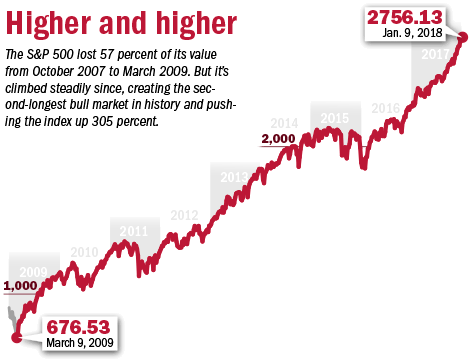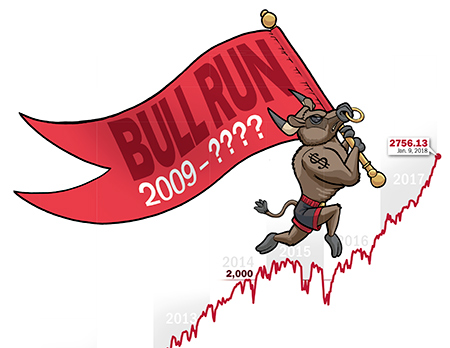Subscriber Benefit
As a subscriber you can listen to articles at work, in the car, or while you work out. Subscribe NowThe stock market’s bull run continued through 2017, with the S&P 500 index advancing an impressive 19.4 percent.
It was the eighth straight year the index has avoided sliding into bear-market territory, defined as a pullback of 20 percent or more. The only longer run in modern history extended from the fall of 1990 to the early spring of 2000.
As 2018 gets under way, investors are wondering whether the good times will continue to roll. On the one hand, optimism is fueled by the economy’s robust growth and the anticipated stimulating effects of the GOP’s newly passed tax-reform plan.
On the other, history has proven that a recession eventually will hit. The only question is when.
Are we at a crossroads? Or are ingredients in place for another strong year for the stock market? We asked six financial professionals to weigh in on what they’re expecting and on how they’re counseling clients to approach their investments.
Stocks might see increase in volatility
 O’Rear
O’RearAlan O’Rear
Old National WealthManagement senior client adviser and Indianapolis market leader
Comments from people seem to be developing two opposite viewpoints about the U.S. stock market going into 2018. People are either optimistic about what the tax cuts will do to stimulate continued increases in stock prices, or they believe this eight-year run must come to an end soon. It can become a challenge to guide people through the emotions that sometimes come with investing decisions. So how do we do that?
Let’s look at some economic facts and then our outlook for 2018. Overall, most major global economies are rising together for the first time in several years, and international trade has given a boost to the U.S. economy. The United States is two years into the process of slowly increasing Fed Funds rates, which should continue this year, and will begin to allow a gradual increasing runoff of its balance sheet.
The Fed has been transparent about its interest and quantitative easing policies, which have been equity-friendly. As the U.S. and the world begin to unwind these policies, we expect that the constant flow of news can cause more volatility in the coming year. Over the past eight years, there has been almost no time when the S&P Value Index beat the Growth Index on a rolling three-year basis. With slowly rising interest rates and the reduction in corporate tax rates, we see a possible shift toward value companies, such as financials, this year.
So how do we guide clients through the differing opinions and possibly more volatility in stocks? Personally, I will be reviewing financial goals with clients and relating these factors to their plans.
Many people might be ahead of their expectations from a few years ago, so revisiting asset allocations or taking some risk off the table might be appropriate. Others might be too optimistic and need to be reminded of what can happen during an unforeseen market correction, like in 2002 or 2008.
Most important, it is an adviser’s job to take the emotion away and reflect on what drives the decisions of the portfolio—the individual’s goals and time horizon to those goals.
International stocks may offer superior returns
 Esposito
EspositoFrank Esposito
The Windsor Group Ltd. managing principal
We expect the nation’s economy to grow for the 10th consecutive year in 2018, making this one of the longest periods of economic expansion since the Civil War, albeit a slow one.
Buoyed by the recently enacted tax legislation, economic growth should approach 3 percent in 2018 while corporate profits could rise more than 15 percent. Increasing corporate earnings is an important driver of stock returns. Stock valuations, typically measured by price-to-earnings ratios, are equally important. With valuations at a 10-year high, the best case is that U.S. stock prices grow along with earnings, but it’s more likely high valuations will mute those returns. Equity market gains should provide long-term investors an opportunity to rebalance their U.S. equity exposure into other investments.
 Despite lingering concerns about China’s economy, stocks of international companies are also experiencing a growth rebound, especially in Asia and the emerging markets. In contrast to the United States, international stock valuations are more favorable compared with their 10-year history. This provides international stocks with additional opportunities for returns as both earnings and valuations possibly increase.
Despite lingering concerns about China’s economy, stocks of international companies are also experiencing a growth rebound, especially in Asia and the emerging markets. In contrast to the United States, international stock valuations are more favorable compared with their 10-year history. This provides international stocks with additional opportunities for returns as both earnings and valuations possibly increase.
While no one can accurately forecast markets, we would not be surprised to see a 10 percent drop or more in stock indexes sometime in 2018. Historically, this is a normal correction that occurs almost every year. We have not seen a correction of more than around 3 percent since the early part of 2016, when concerns about China were a primary focus.
Finally, the Federal Reserve is expected to raise short-term rates two to three times in 2018. This creates an opportunity for investors to increase yields from short-term, high-quality investments. The Federal Reserve also will attempt to slowly increase long-term interest rates by selling the bonds purchased through “quantitative easing,” or QE. An unwinding of QE represents an unprecedented action by the Fed and could cause disruptions in the bond market. Finally, the yield an investor receives for taking credit risk is historically low. We believe investors should avoid taking considerable credit risk in pursuit of higher yields.
Economy likely not on verge of recession
 White
WhiteTiffany White
Halter Ferguson Financial Inc. financial planner
This past year was quite a ride and certainly not for the faint of heart. To say there’s been a lot of political noise out there would be an understatement. Nonetheless, markets were significantly higher. And, in fact, the economy started heating up even before the 2016 election.
Looking ahead, we don’t think it’s likely we’ll enter a recession in the near term. (You don’t have to have a recession to have a significant pullback in the market, however.) We expect economic growth to stay strong. Millennials continue to find work, buy vehicles, get married, have kids and buy homes. This surge in spending stimulates the economy.
Wages also are increasing for many Americans, which puts some pressure on corporate profits. At the same time, though, the economy is continuing to grow, which bolsters corporate revenue and pushes up stock prices. The economy is staying strong and even getting hotter in some respects, though it doesn’t feel like it at times.
The reason we invest is to help us achieve an objective, such as maintaining a lifestyle, retirement, leaving a legacy, etc. If you’re no longer working and are in the spend-down phase of your life, you should always have cash on hand. You should be replenishing that cash and making sure you have at least a year’s worth of liquidity. Having enough cash on hand to cover your short-term needs means you’ll better weather the inevitable ups and downs of the markets.
On the other hand, after such a long bull market, some investors have gone too far toward caution and defensiveness. You need to be positioned in your investments so that you can participate in that growth to get closer to achieving your financial goals.
In the digital age, it’s become increasingly hard to not become distracted by all the noise and shiny things, i.e. Bitcoin. It’s important that, as investors, we attempt to tune out the raucous, remember the fundamentals of investing, and keep our eye on the prize.
Stock market positioned for additional gains
 Joyce
JoyceAlexander Joyce
ReJoyce Financial LLC president and CEO
The stock market has had a good run. But as the old saying goes, the market climbs a wall of worry, and the long bull run that began in March 2009 makes people nervous about how long it can last. Yet, in our opinion, the stock market should have an impressive showing in 2018! If price-to-earnings ratios remain constant, as they have the past two years, the S&P 500 should increase, in line with earnings gains of about 12 percent to 15 percent.
The global stock market (as represented by the MSCI AC World Index) has posted a gain for 13 consecutive months (a record). Every one of the world’s 45 largest economies tracked by the Organization for Economic Cooperation and Development is expanding. Economists are forecasting acceleration in world gross domestic product in 2018 from 2017 levels.
U.S. inflation has been averaging below 2 percent for the past 20 years. We believe the record will extend to at least 21 years. Globalization and technology are secular drivers of low inflation and default levels are below 1 percent.
You might think past returns over a long period—say 100 years—would be a sensible place to start with a forecast of future returns. But investing doesn’t work that way. What matters to today’s buyer of a stock or bond is not what it did in the past but what it earns for the buyer at today’s purchase price.
As interest rates slowly climb and economic numbers strengthen, our clients are still on edge. We believe this is due to the uncertainty of the market. The old saying is that everything that goes up must come down. As optimistic as I am, and as stubborn as I might be, I can see the potential for what I would call a cleansing of the market, or a slight devaluation. At the moment, there just isn’t much to invest in at attractive prices.
Bonds and interest rates have an inverse relationship—if rates go up, bonds go down. As we know, interest-bearing accounts like CDs aren’t paying anything. Precious metals like gold have had a good year but, like any commodity, can be volatile. We believe this is a tough (and politically treacherous) market to time or plan for.
We take seriously our responsibility to provide clear, confident, accurate advice to all our clients. We want them to only have to retire once.
Strong earnings support run-up in stock prices
 Bradley
BradleyMatthew K. Bradley
Peloton Wealth Strategists chief investment officer and managing partner
Stocks have been in rally mode for almost a decade since bottoming in 2009. Now many investors are asking, “How long can the good times last?” While this bull market will inevitably end someday, answering this question is more complicated than counting years. Stock prices are undeniably high relative to history (all-time highs, in fact), but so are the earnings of the underlying companies. Investors can debate the fair price for any individual stock, but broadly speaking, much of the significant rise in prices is supported by equally strong operating results of businesses. When companies earn more, they are more valuable, and investors bid up the prices of their stocks.
In the current environment, we highlight the distinction between stock price and stock valuation. Just because a stock has gone up appreciably doesn’t mean it is necessarily “expensive” or overvalued and therefore due to tumble. If the company’s profits have increased at the same rate as the price, the stock is no more expensive now at a much higher price than it was previously at a lower level.
Investors positioned for an imminent crash might be disappointed—particularly with valuations at realistic levels and underlying businesses thriving in a growing economy. No one knows when this bull market will eventually end, but one Wall Street adage contends that “bull markets don’t die of old age.” They typically end for reasons other than the mere span of time, and usually for reasons not currently on anyone’s radar screen. This makes planning for a downturn extremely difficult. “Getting out” at the perfect time is virtually impossible, and it’s dangerous to try.
When investment portfolios are customized properly for each investor, corrections and other short-term market pullbacks become less worrisome. We can match investments with investors’ needs so they continue to meet short-term and long-term priorities during bull markets and also when the next meaningful pullback finally occurs.
Tech, 3 other sectorsoffer opportunities
 Goel
GoelSunjay Goel
Spectrum Management Group portfolio manager
The global bull market in stocks and bonds has benefited greatly from extraordinarily low interest rates and quantitative easing from global central banks worried about deflation. This policy stance led to an environment where stocks thrived as many companies aggressively repurchased their shares and raised their dividends, in some cases by borrowing at very low interest rates from yield-hungry bond investors.
This period also was characterized by baby boomers’ extending their planned retirement to rebuild their savings from the Great Recession, and millennials’ opting to delay marriage until they, too, were on a firm financial footing. With a U.S. unemployment rate at 4.1 percent, a stock market that is up more than 300 percent, and the Case-Shiller Home Price Index back to 2007 levels, it is fair to say the Fed’s mission is, indeed, accomplished.
Our research indicates that, over the next six to 12 months, opportunities remain in four stock sectors: The technology and industrial sectors have been the consistent leaders in this bull market, and we believe this will continue. Businesses are still needing to modernize their capital equipment and workforce, and will continue to invest in productivity-enhancing technology. The financial sector has largely lagged but is now well positioned for leadership. Banks have repaired their balance sheets, and now dividends are growing, and loan growth is improving. Finally, as millennials purchase their first homes, cars and other household goods, the consumer-discretionary sector is positioned to benefit, despite the rapid changes occurring in the retail landscape.
An all-weather strategy for investors to consider, irrespective of age, is a basket of dividend-growth stocks.
Many companies that regularly raise dividends do so because they have strong businesses that generate a growing stream of free cash-flow, i.e. cash available to shareholders after investing in their businesses. Our research indicates that the dividend for the S&P Dividend Aristocrats Index has compounded at a 10.6 percent annual rate since 1990, well above the 2 percent rate of inflation. Furthermore, this index has outperformed the S&P 500, on average, by 2.3 percentage points per year since 1990, with 7 percent lower volatility. The competitive position and balance sheets of businesses can change over time, so it is important to periodically ensure that the dividend is sustainable.•
Please enable JavaScript to view this content.

